
The Best of Everything
Encyclopedia Entry • Films Main
A Woman's Face
1941

Critics' Reviews • Our Reviews • Movie Posters • Lobby Cards • Misc. Images
Click here to see photos from the film.
MGM. 105 minutes. US general release: 5/15/41.
DVD release: 2/12/08 (part of Joan Crawford Collection 2) DVD release: 2/28/17 (Warner Archive Collection)
Cast: Joan Crawford (as "Anna Holm"), Melvyn Douglas, Conrad Veidt, Osa Massen, Reginald Owen, Albert Bassermann, Marjorie Main, Donald Meek, Connie Gilchrist, Richard Nichols, Charles Quigley, Gwili Andre, Clifford Brooke, George Zucco, Henry Kolker, Robert Warwick, Gilbert Emery, Henry Daniell, Sarah Padden, William Farnum.
Credits: From the play "Il Etait Une Fois" by Francis de Croisset. Screenplay: Donald Ogden Stewart. Producer: Victor Saville. Director: George Cukor. Camera: Robert Planck. Art Director: Cedric Gibbons. Music: Bronislau Kaper. Costumes: Adrian. Editor: Frank Sullivan.
Plot Summary: A remake of the Swedish film of the same name, MGM's A Woman's Face was reshaped into one of Joan Crawford's best vehicles. Told in flashback from the vantage point of a murder trial, the story concerns a female criminal whose face is disfigured by a hideous scar. The plastic-surgery removal of this disfigurement has profound repercussions, both positive and tragically negative. The film's multitude of subplots converge when Conrad Veidt, Joan's lover and onetime partner in crime, is murdered. Melvyn Douglas costars as the beneficent cosmetic surgeon who becomes Joan's lover, while Osa Massen appears as Douglas' vituperative wife. Making his American screen debut in the role of Veidt's father is Albert Basserman, who spoke no English and had to learn his lines phonetically. Both A Woman's Face and its Swedish predecessor were based on Il Etait Une Fois, a play by Francis de Croiset. ~ Hal Erickson, All Movie Guide
Notes: • In production from 1/23/41 to 3/29/41. • This "Face" was a remake of the 1938 Swedish film "En Kvinnas ansikte" starring Ingrid Bergman. • The snow scenes were shot in Sun Valley, Idaho. • In a 2002 bio, co-star Conrad Veidt was quoted as saying that this was his favorite of his films.
|
|
When Victor Saville, producer of "A Woman's Face" now at the Capitol, stopped in town recently he told this corner that he had taken a "straight-on-the-nose" melodrama and tried to give it psychological overtones. It sounded promising, but after seeing the film itself we can only wish that Mr. Saville, George Cukor, the director, and Donald Ogden Stewart and Elliot Paul, the scenarists, had cut through all those "overtones" and been content to take their story for what it was worth. For as melodrama, sheer and simple, the story behind Anna Holm's murder trial is often superbly effective, but when it attempts to become a study of emotional anguish it merely betrays the essential hokum of which the film is constructed. For the story basically is no more than a good old-fashioned thriller which makes use of most of the tricks of the old ten, twent' thirt'—the mad villain, the chase on sleighs to save an abducted child, the latter which at the last moment whitewashes the accused. By flashbacks from a Swedish court room, the camera recounts the chain of events through which a horribly disfigured woman is restored to her natural beauty by a plastic surgeon, but only after she has fallen under the spell of a frustrated madman. Because of her lover she becomes involved in an attempt against the life of his uncle's child, an attempt from which she shrinks only at the last moment. In order to save the child she shoots the lover, an act not fully explained until that inevitable warning note bobs up at the trial. Throughout, the sense of impending violence is deftly accented by all the means of a shrewd director—in the photography which is stunningly and suggestively used, or in the sound track where the casually revealed plot against the child's life is given a dreadful impact by the reiterated bars of an old spinning song. But the film becomes pretentious when it infers that its villain is a Swedish Quislingist; and certainly it is pretentious in demanding that Joan Crawford wear a horrible facial disfigurement for half of the picture. If "A Woman's Face" were really a sensitive analysis of lonely and embittered emotion, the use of such a scar might be justified. For the sake of a macabre Gothic tale, it is needlessly cruel. Miss Crawford, however brave she is to face her fan clubs in such a role, also seemed to lack the ability to project more than the superficial harshness of the character of Anna Holm. But under the circumstances the fault in her performance lies more with the script than with herself. Conrad Veldt, as the demented villain of the piece, again as suavely satanic a figure as ever, cast a spell over an audience, and there are excellent performances by Melvyn Douglas, as the plastic surgeon; Albert Bassermann as the aged uncle, Donald Meek and Reginald Owen as a pair of shady accomplices. But one cannot make a silk purse out of a sow's ear; and the ultimate failure of "A Woman's Face" lies in the fact that it has not remained within the limitations of its material. Beneath its spurious wraps it has the heart of a penny thriller. A penny thriller is wonderful entertainment, of course, but only when it's honest.
Variety (1941) Miss Crawford takes a radical step as a screen glamour girl to allow the makeup necessary for facial disfiguration in the first half; an innovation that might well interest other screen stars with dramatic tendencies to be receptive to similar roles that may require temporary or permanent marring of facial beauty....Miss Crawford has a strongly dramatic and sympathetic role...which she handles in top-notch fashion.
Karli Lukas, sensesofcinema.com (2000) Cukor exhibits a great ability to reveal the turning points of character through his use of seemingly understated, but in fact very clever mise-en-scene. I love the way that he has directed Crawford to dance amongst pools of light and shadow to heighten suspense (and show off her great facial structure). While admittedly borrowing such techniques from the stage, the effect is anything but stagy - instead it lends the film some very noiresque elements. The scenes where Cukor finally reveals Crawford’s scar and her later facial reconstruction are masterful. Equally spectacular is the use of back projection during the cable car and sleigh ride scenes, which once again arguably serve to isolate Crawford’s face as she goes through her crises of character....
|
If you've seen A Woman's Face and would like to share your review here, please e-mail me. Include a photo of yourself or avatar, a star-rating (with 5 stars the best), and any of your favorite lines from the film.
|
Rating:
I recently watched A Woman’s Face (1941), and I am not sure what more I can add about this film, which has already has been heavily reviewed on IMDB and elsewhere. What is interesting is that earlier reviews of the film are lukewarm to good, and more recently the film seems to have grown in the estimation of many, in particular regarding the acting of Joan and Conrad Veidt, and the direction of George Cukor.
Joan plays Anna Holm, a woman who had the right side of her face horribly scarred in a childhood fire precipitated by her drunken father. Prior to this, her mother died. Thus, Anna is a disfigured orphan who grows into an embittered blackmailer. Anna must eventually choose between good (a plastic surgeon played by Melvin Douglas) and evil (a dissolute playboy played by Conrad Veidt). Which does Joan choose? Watch the movie! However, AWF is an interesting psychological set piece, courtroom drama, thriller, and love story rolled into one with a faint whiff of film noir.
Semi-random thoughts: • If I had not known Cukor directed AWF, I would not have guessed in a million years. The film---especially the compelling cable car scene---seems more like Hitchcock than Cukor. • It took a few minutes to stop thinking “Major Strasser!” every time Conrad Veidt appears on the screen, but he is great as oily Disciple of Lucifer, Torsten Barring. • The supporting cast is delicious, from Donald Meek and Marjorie Main to Reginald Owen and Albert Bassermann. About the only one I wanted to slap was Osa Massen as the cheating wife of the good doctor. And Joan took care of that for me about halfway through the film! • Keep a keen eye out for Henry Kolker, a favorite character actor of mine from that era, as the judge. Kolker was Marcus Morton, the cad in JC’s first featured movie, Sally, Irene and Mary (1925). Henry and Joan made four movies together from 1925 to 1942. • Camera work and cinematography are excellent. I particularly like the opening courtroom scene as the camera pans across the witnesses; you see on their faces hints of their personalities that will be revealed further as the film develops. The use of light and shadow to convey good and evil is powerful, and the overall effect is reminiscent of later noir pics. • Joan is less made up---albeit still in gowns by Adrian---than we’ve come to expect from her MGM clotheshorse days, but she really looks naturally beautiful in this movie, especially in the first half of the film.
Perhaps the renewed interest in A Woman’s Face derives from the fact that this may be Joan’s most acclaimed film from the early 1940s, when her reign as Queen of the MGM Lot was coming to a close. Also, her decision to take a chance on playing a less-than-glamorous role and the acting chops on display in AWF foreshadow her more famous run of excellence from the mid-40s to mid-50s.
While all the aforementioned cinematic themes told in flashback format could have devolved A Woman's Face into a 106-minute chore to watch, Joan & Co. pull it off under Cukor's direction.
reinventedsky (June 2017) Rating:
There’s a scene in Ryan Murphy’s Feud, a sympathetic take on Joan Crawford’s embittered rivalry with fellow screen legend Bette Davis as well as a commentary on sexism and ageism in Hollywood, where Jessica Lange (playing Crawford) responds to Jack Warner’s blunt rejection by decking across a lounger; she tilts her head upward, throwing her God-given cheekbones into the relief of the light. Lange, another actress whose facial planes were designed for celluloid, was imitating one of Crawford’s most spellbinding techniques on film: a magnetic sense of suggestion using the mere turn of angle.
In A Woman’s Face, a somewhat meta drama that riffs on the real-life legend that was Joan Crawford’s brand of glamour, George Cukor pens a grisly love letter out of her chiselled mug. As she neared the end of her tenure with MGM, Crawford churned out a sensitive performance in a stunningly directed film in which she is at once inhibited by and ultimately in control of using her angles to tell a story of a woman’s sexual and social oppression, wrapped neatly in a narrative redemption arc.
Unfolded through flashbacks from the perspective of a murder trial, Crawford plays Anna Holm, a facially disfigured blackmailer cast out by the world. When she encounters the silver-tongued, and ultimately evil, Torsten Barring (Conrad Veidt, oozing urbane villainy) he becomes the first man to embrace Anna’s ghoulish appearance; eventually, he manipulates her yearning to be accepted by convincing her to comply with a sinister plot: to murder his toddler nephew for the sake of swindling his inheritance. This is countered, however, when Anna meets a doctor who operates on her face, restoring her normality to the world which she gradually feels more comfortable in.
Fiercely restrained in his direction of Crawford, Cukor puts a velvet leash on her infamous excesses, and it reflects in a performance founded on nerve and restraint. Crawford speaks her lines and reacts to situations like a primal being -- the look of physical relief across her face as Anna is held by a man for the first time is heartbreaking, as are the moments in which Crawford finds animalistic satisfaction in Anna’s desperation to be seen as normal. (Early on in the film Anna gets excited about having bought a blouse, mustering an almost panicked glee at the thought of looking nice; she’s mocked, and Crawford’s reaction is so visceral you can almost taste the anger.)
In real life, Crawford was thought to have been bitter that her performance in A Woman’s Face was not duly recognised in the vein that her later work in the '40s was. But if Ryan Murphy’s Feud accomplishes anything, it should be a renaissance of the better parts in Crawford’s filmography. In another scene from Feud, Susan Sarandon, playing Bette Davis talking to Crawford, remarks: “I want you to try, Joan, because when you try, dammit, you’re good. You’re really good -- I’ve always thought so.“ Now, were that ever a real-life interlude shared between the two warring actresses, one imagines A Woman’s Face would have been a keen influencer.
Rating:
I have to reach for the highest rating on this one. I continue to be impressed with Miss Crawford’s performance for years after my first viewing of "A Woman’s Face." It had an intriguing story and history (having been filmed once before with Ingrid Bergman in Sweden). Miss Crawford certainly went to great lengths to find a good story and took her chances on the final shooting script. A young girl burned in a fire caused by her alcoholic father scars her for life. Suffering the loss of her father, she is alone in the world. Her face horribly scarred, she turns to a life of crime. Hmmm, would this make a good movie? When I see and hear what goes on in the world, nothing seems implausible.
Mr. Victor Saville took over production and assembled an amazing cast and crew. The screenplay is from Donald Ogden Stewart (sadly, a victim of the 50s witch hunt). It can miss at some points; however, the production of this film has something of a film noir feeling that helps give it what the cameraman Robert Planck knew it needed. Now familiar with Miss Crawford, he captures the suspense of the script and the beauty of Miss Crawford. He films with a slick and crisp touch to this production, somewhat like Hitchcock’s “Suspicion” that same year, beautifully filmed and glossy (never mind the scripts defects). Here it is not enough to drag me down. This is a psychological thriller with scars and suspense.
The shadiness of the characters and the feeling of something haunting in the script is a departure for director George Cukor (“The Philadelphia Story” and “Born Yesterday”). I wish he saw the whole thing through -- but part of the problem, as always, is the studio system itself, along with the Hayes Code and those darn happy endings. I keep all of that in mind when viewing these films. Cukor does present an entertaining and suspenseful film and concentrates heavily on Miss Crawford’s performance, which is engrossing and well thought out.
Every actor in this movie (except for Miss Crawford) began their craft on the stage. Mr. Cukor hails from the theater, but it is interesting to watch this “motion picture actress” work with such pros. The outcome is as good as any “stage”-trained actress.
Mr. Cukor directs some of the finest character actors of the day and gives each a pocket-full of great characterization and lets them run with it. (Which they would have done anyway!)
The movie opens with Donald Meek as the waiter: He is one of my favorites and I am happy to see him anytime. Here he is still a bit befuddled and skittish, but he is really a slimy, greedy, nasty man. (Great comedy in his courtroom scene.) Reginald Owen (appearing with Miss Crawford in a total of five films): He is never boring. This time working as a con man for Miss Crawford’s blackmail business: He is always superb and sublime. For instance: The sweat running from his forehead in a few scenes. He acts with every pore!
Mr. Conrad Veidt shares with us his intensity and devilish charm. He was already a great success in Europe (another causality of Hitler). His character also is seeking power over the world, and he is totally warped and wicked, but charming and handsome as well. (No wonder Crawford goes to work for him.) I love him (I would share an espresso with him and talk about music and art); I think he deserved a nomination for his role, as did many of Miss Crawford’s supporting co-stars (Jack Carson, Ian Hunter, Sydney Greenstreet, and Cliff Robertson): Look into Veidt's eyes and in some scenes you see the madness that is running his soul. Miss Crawford has been lucky to work with so many intense and professional actors. She benefits from these extremely talented people and so do we!
Marjorie Main is no doubt in the top ten, and here she has a fun bit of characterization as the sneaky, suspicious housekeeper with dirty hands and a nasty jealous streak. She gets herself involved in the proceedings and holds the key to “Anna’s’ guilt." I am happy to see her away from the farm -- she plays her character so uptight that you can feel she is going to spin out, she is wound so tight.
Connie Gilchrist is like Lee Patrick (they seem to be in my favorite films and show up everywhere): Here she gets to play a different hand as well and is very good as the tough masseuse-cum blackmailer. Always gruff: here she gets to sling some shots at Miss Crawford but is still afraid of her.
Osa Massen, finally put by the studio to good use as the wimpy, whining, cheating wife of Melvyn Douglas, is gorgeous in her “ Paris ” gown. She is feminine and sophisticated also -- an obtuse woman and a liar! But stunning!! Sadly she never got a better role. I think she ended up with Abbott and Costello.
Then there is Albert Basserman (also forced to flee Germany ), appearing in his sixth American movie. His specialty was wise, well-educated older gentlemen. Max Reinhardt, whom he trained and studied with, would be proud. His best moments are in the courtroom and when “Anna” kills “Torsten.” It's the eyes. A real actor acts with his eyes, and he says a lot with them. (Watch Crawford’s eyes, too!)
The minor players are not just day extras but some of the most experienced actors in Hollywood, with the history to prove it. They showcase themselves (briefly) to full advantage: Henry Daniell, William Farnum, and George Zucco (where were they when Joan filmed “Strait Jacket’?) Character equals class!
Richard Nichols as the boy who is almost murdered by “Anna” and Mr. Veidt is a ham but an adorable one. He has some touching scenes with Miss Crawford.
Mr. Melvyn Douglas brings his usual effortless acting to the proceedings. He is the only nice person in the movie and helps make it all plausible. Sometimes I think someone else could have been cast, but he has become like William Powell for me -- I just like having him around!
Thank you Mr. Mayer.
 Stephanie
Jones (July 2009) Stephanie
Jones (July 2009) Rating:
As her 18-year MGM tenure neared its end, Joan turned in a dazzling series of performances in an interesting, diverse 4-film run, culminating with 1941's A Woman's Face. (The others: The Women, Strange Cargo, Susan and God.) Though she would make another 3 films before her departure in 1943, "Face" stands as her last excellent MGM movie, and as an indicator of the upcoming intensity and depth that would become the signature of her 1940s Warners and early-50s independent work.
In "Face," Joan plays "Anna Holm," a facially disfigured member of a blackmailing gang that operates out of a louche roadhouse frequented by slumming aristocrats who get off on watching the decadent goings-on there, like... gasp! women dancing together!
Anna's facial scars have left her embittered -- and who wouldn't be: Even her own gang members are nasty to her, wondering loudly when she's in earshot what man would ever love such a "gargoyle" and cruelly leaving mirrors around so she can be reminded of her deficiencies.
Anna finds a bit of hard solace in the interest of the sinister and seductive Torsten Barring (Conrad Veidt), one of the roadhouse denizens and the first man who's ever paid sexual attention to her. In her outer scars he sees a reflection of his own inner demons: "We're both proud, both wretched," he proclaims as they toast each other defiantly: "Skoll, Satan!"
The movie is basically a battle of Good vs. Evil for Anna's soul, and the fight is an interesting one. Despite Anna's hardened exterior, she can also be shyly, girlishly delighted over finding a pretty blouse in a store, or profoundly moved by hearing the music of Chopin or by thinking of the love letters written between Chopin and George Sand. (The expression of love is meaningful to her: One of the most frightening, yet sadistically exhilarating, moments in the film comes when the blackmailing Anna confronts a dumbly pretty society woman -- Osa Massen -- about the shallowness of the feelings the woman has expressed in letters to her lover: "Do you know anything about love in that miserable soul of yours?" Anna screams... while repeatedly bitch-slapping the once-simpering, now-cowering woman. It's a Joan-scene on par in intensity with Sadie's confrontation of the minister in Rain or of Letty Lynton's denouncement of her former lover whom she's just poisoned.)
Torsten's seductive Devil is countered by the Good Doctor (Melvyn Douglas) who operates on Anna, then wonders aloud if he's created "my Galatea [a reference from myth to the sculpture created by Pygmalion that the goddess Aphrodite brings to life], or my Frankenstein." He knows that Anna's inner scars run much deeper than those on her face, and are not as easily erased. Anna, for her part, mocks his concerns, asking him if, now that she is transformed outwardly, her soul is different than that of any other cruel, beautiful woman. (An interesting point. Anna doesn't much care about her soul right now. While the Good Doc has been busy fantasizing and playing Pygmalion, Anna's just interested in looking "normal" and acting like any other woman.)
Once Anna's face has been restored, little children and soldiers now smile at her on the street as she makes her way back to Torsten, to whom her sexual soul still belongs.
"The world belongs to the devil," he later purrs as he strokes her face where her scars used to be, and tries to draw her in to a dastardly plot to kill his little nephew for his inheritance. By this time, though, the family's kindness to Anna also has a powerful hold on her -- "You couldn't be mean. You're too pretty," the charming little nephew (Richard Nichol) has beamed, melting Anna, in spite of herself, and her self-knowledge, and her now-fading loyalty to Torsten.
Another interesting symbolic touch in her new life involves music: The same composition that she and Torsten had once taken turns playing dramatically to each other on the piano (Anna: "I play the piano and violin. The Wonder Girl has also tried poetry, art, and alcohol.") is now, at a family birthday party, transformed into a jovial, rollicking folk dance. This contrast is the heart of the battle and is further reflected near the end of the film -- In the past, Torsten has promised her The World: "Women such as you have been empresses..." But by now Anna's scarred face is gone and her scarred heart healing and her needs much simpler:
"I want to go to the market and cheat the grocer. I want to belong to the human race. I want to belong."
Anna's journey is a moving one, and Joan's performance subtle and often painful and uncharacteristically awkward. As Brad mentioned in his review below, it is indeed a crime that MGM did not tout Joan's performance in this role (or any other role, for that matter) for an Oscar.
I think it's also a shame, however, that Joan herself has not been given proper credit for her own performance here. While "Face" director George Cukor has been lauded for "keeping Joan in check" -- instructing her to play her courtroom scene as if she were reciting the multiplication table, for instance, so she would appear appropriately drained -- there are also multiple moments in this film of an actress making her own emotional decisions: Anna unexpectedly touched by inner bursts of feeling but forced out of self-defensiveness to just as quickly mock the brief glimmers of hope and beauty. Anna, pre-surgery, walking along store windows or in front of mirrors and wanting, but not wanting, to check her reflection. Anna's visceral reactions to Torsten as he's touching her, or about to touch her, or even behind her where she can't see him but can clearly just feel him...
A Woman's Face is well-directed, and very interestingly written. But it's just as evidently well-acted. Joan's mastery of the character's pain and nuances are a brave and original harbinger of her Oscar-nominated/winning work to come in the next decade or so.
LuLu (July 2006) Rating:
I must say when i started to watch this movie i was Very Excited to see it: Joan Crawford with a scarred up face--Wow, this is gonna have some AMAZING dramatic scenes. Well, let's just say i was kind of right. Joan's face is unscarred within the first 30 minutes i think, and with the removal of the scars comes the removal of any good content. Joan's a very upset woman with a past; she meets a man who just happens to be a blackmailer; she goes to collect money from a woman about some love letters but gets caught by the woman's husband who happens to be the leading scar removal doctor in Europe; he removes her scars and sends his "frankenstein" on her merry way; she goes back to the blackmailer and finds out he has a special mission for her; blah blah the end. This is a kind of interesting movie for Crawford fans because she's in between periods; this is a transition between her glamour years at MGM and her Noir Years at Warners. If u can find it i guess it's worth the watch.
Brad (December 2005)
This is a powerful movie for Joan Crawford. To me this movie
represents Joan's life. Scarred early in life by a tragic fire Joan's
character Anna must face a cruel and harsh world where she does not fit
in. Similar to Joan's own life where she had to work extra hard to get
what she wanted out of life.
Joan removes all traces of glamour and style early in the movie to convey a woman who desperately wants to be needed/love and be loved. While her character is a crook, deep down she has a heart of gold and just wants someone to believe in her. Watch the movie to see Joan bring her character to life and into the light. If you have not watched A Woman's Face do so, for Joan gives a great performance. Crawford has a way with the camera and with the lighting. Watch her face throughout the movie and see how it reacts to the lighting. This is a movie that you want to watch more than one time, first for the plot, second to see Joan's reactions to the light. While Norma Shearer tended to overact and exaggerate her facial movements, Joan (especially in this movie) used facial movements to her advantage. I find it a crime that Joan was never nominated by her "home" studio for an Academy Award - this is one movie that she certainly deserved to be nominated for.
|
Original 1941 Release
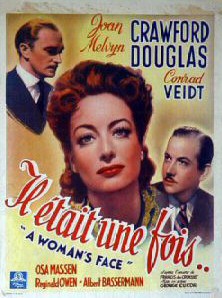
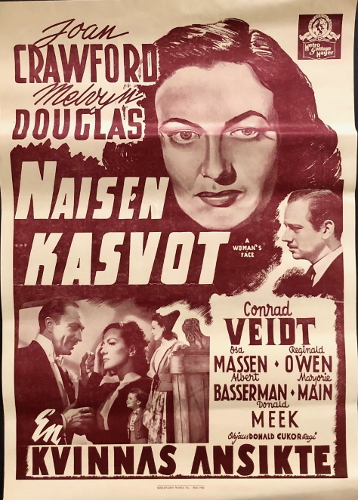


Above: Belgium, Finland, France, and Germany.
Below: Italy.


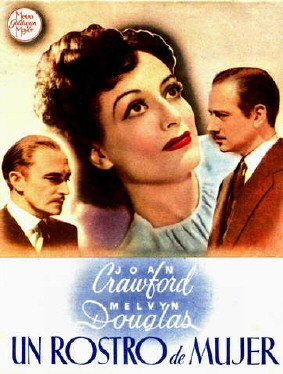
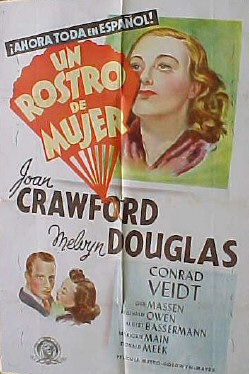


Above: Spain. Below: Sweden.
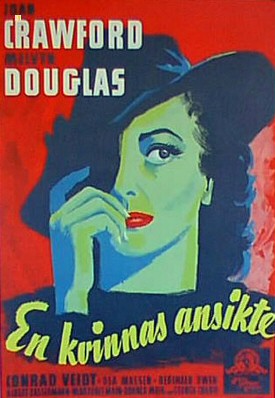
Below: United States.
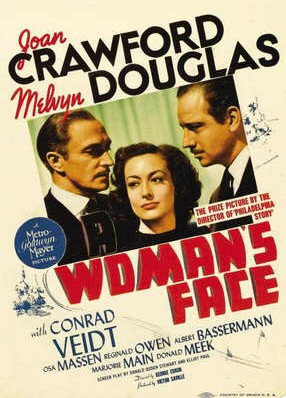


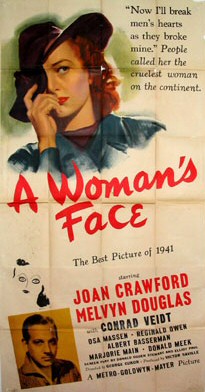
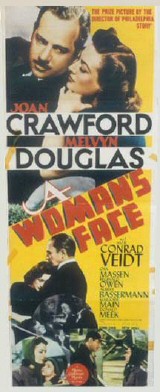
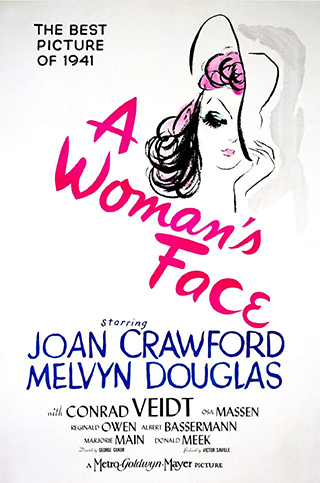
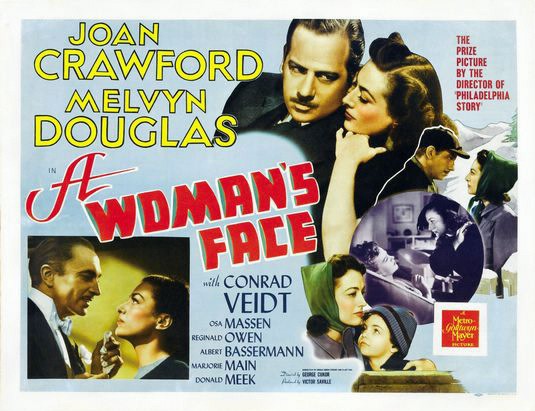
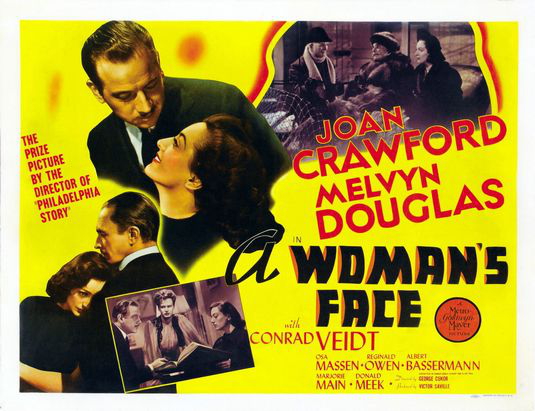
US 1954 Re-Release
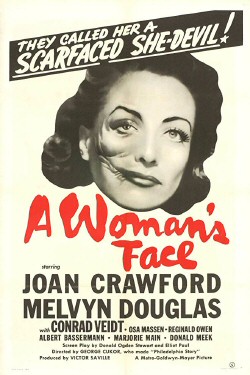


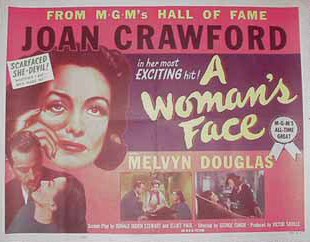

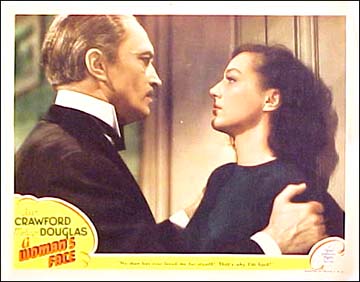
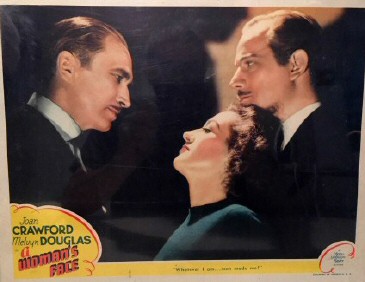


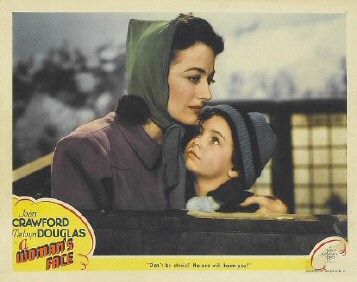

Above: 1941 U.S. lobby cards. Below: 1954 U.S. re-release lobby cards.

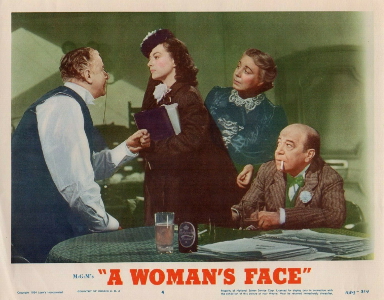






Below: Italian lobby cards (13 x 17 inches)







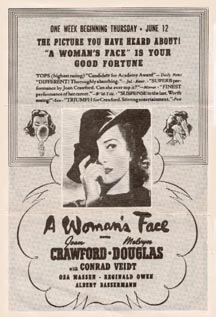
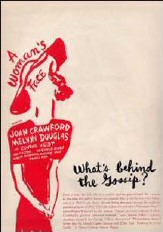
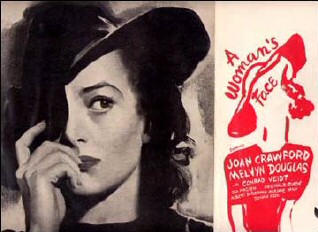
Above: US mailer and promo brochure.
Below: Ad in US Ladies' Home Journal (June 1941), and US pressbook pages.

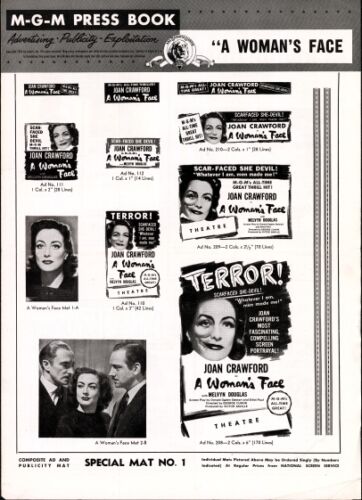


Below: US trade ad, US herald, Finnish flyer/poster (16 x 23 inches), and Dutch magazine ad.
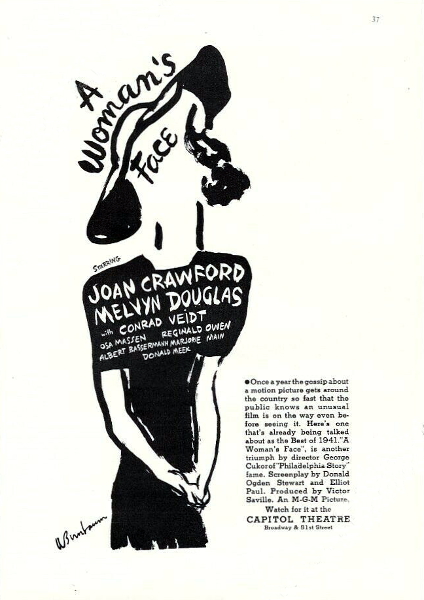
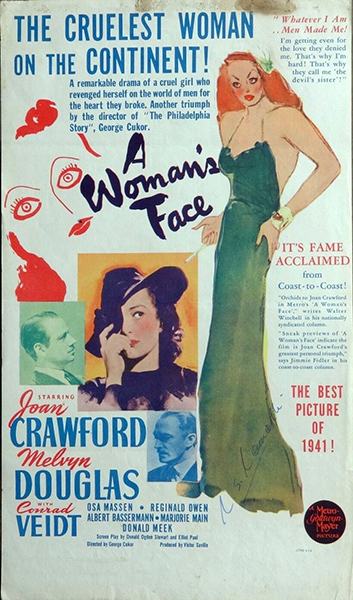
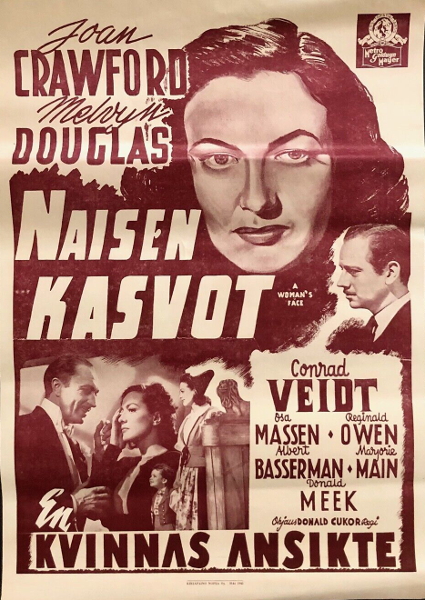

Below: Danish program, 1950 Austrian program, Spanish herald.
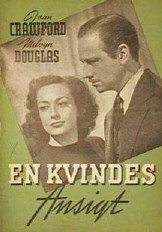
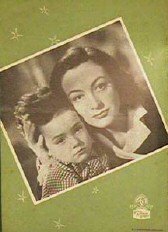

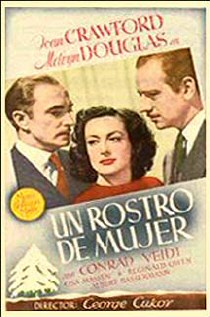

Above: 1941 Woman's Face marquee (at left, under "Iowa" sign) in Keokuk, Iowa.
Below: 1941 Woman's Face marquee (Wilma Theatre) in Coeur d'Alene, Idaho. (Future home of Christina Crawford.)

The Best of Everything